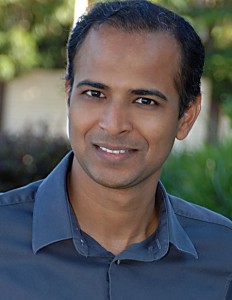 Milind Chabbi’s (CS PhD ’15) relationship with Rice began with a textbook he read while working on his master’s degree in Arizona. “I became fascinated with Keith Cooper’s textbook, “Engineering a Compiler,” and longed to take his class,” he said. In addition, while doing his masters, he read a paper by another Rice CS professor, John Mellor-Crummey, who had introduced the MCS lock (a software locking algorithm) in a 1991 paper. Fifteen years later in 2006, the same year Chabbi was introduced to the work, Mellor-Crummey’s research was awarded the distinguished Edsger W. Dijkstra Prize in Distributed Computing prize. “This was the kind of research I wanted to pursue,” he said.
Milind Chabbi’s (CS PhD ’15) relationship with Rice began with a textbook he read while working on his master’s degree in Arizona. “I became fascinated with Keith Cooper’s textbook, “Engineering a Compiler,” and longed to take his class,” he said. In addition, while doing his masters, he read a paper by another Rice CS professor, John Mellor-Crummey, who had introduced the MCS lock (a software locking algorithm) in a 1991 paper. Fifteen years later in 2006, the same year Chabbi was introduced to the work, Mellor-Crummey’s research was awarded the distinguished Edsger W. Dijkstra Prize in Distributed Computing prize. “This was the kind of research I wanted to pursue,” he said.
In 2008, Chabbi was considering several graduate schools. Chabbi was intrigued and sent a research inquiry to Mellor-Crummey. The Rice professor promptly replied, saying he had just the right project for Chabbi. “He sent a big document for me to read and I was really excited,” he said. “This was just the sort of research I wanted to do.” Chabbi applied to Rice and was admitted to the CS PhD program but could not attend due to immigration issues. “John and Rice worked very hard on my behalf,” he said, “and they allowed me to join at a later date. Which I did in 2010.”
When he finally arrived at Rice, he immediately signed up for Keith Cooper’s class as well as a course by his adviser, Mellor-Crummey. It was in one of Mellor-Crummey’s courses that Chabbi developed an intense interest in parallel computing. The students were challenged to solve a classical numerical algorithm in the best possible way.
“I took it very seriously.” said Chabbi. “I kept refining and refining it, and we were working on a new machine (Rice University’s Blue BioU cluster) that was newly introduced and it was highly complicated to program for high performance.” His determination to make the code shine led to results so good that the solution was not improved by other students while he was a PhD student. “I don’t know if anyone has improved upon it in the last two years,” Chabbi said, “but when I graduated, my code was the best performing one on that machine.”
As Chabbi was exploring research topics in 2011, Mellor-Crummey showed him a large code from the Lawrence Berkeley National Labs. “John showed me a few inefficiencies in the code,” he said. “I realized someone with John’s expertise could pick up those inefficiencies just by eyeballing the code, and I wondered if there was a way to automate inefficiency identification.”
Chabbi’s subsequent research identified the broader implications of “automatic inefficiency detection” for a wide range of software, which eventually led to his first research publication. “Lowering the time to identify inefficiencies and expanding the scope in other dimensions led to two more papers,” he said.
Three years later and in a completely different context, Chabbi and Mellor-Crummey were once again looking at yet another large software package from Berkeley. Chabbi said, “John and I noticed problems with locks and we had a flash of insight.” This time, it was an improvement to his adviser’s award winning research on locks. “Machines have changed in 20 years, new problems have emerged, and we require newer algorithms to solve the locking problem.” Chabbi’s improved version of the lock led to dramatic results, and his paper was published in PPoPP’15, a premier parallel computing conference.
 After finishing his PhD, he joined Hewlett Packard Labs in Palo Alto as a researcher and his research interests continued to expand. “I got new opportunities; I can solve problems of larger size on newer hardware. I can influence the design of hardware to better match the needs of the software and tune software to take advantage of new hardware.”
After finishing his PhD, he joined Hewlett Packard Labs in Palo Alto as a researcher and his research interests continued to expand. “I got new opportunities; I can solve problems of larger size on newer hardware. I can influence the design of hardware to better match the needs of the software and tune software to take advantage of new hardware.”
His advice to new graduate students is to follow their instincts. “Work on research topics that interest you most – not necessarily what is hot in the market. It might coincide, but you will put in a lot more energy and enthusiasm if you like the project.”
In addition to meeting other graduate students and publishing regularly to improve visibility in the community, Chabbi also recommends finding a way to give back to Rice. “I felt compelled to give back,” he said. “I found two places where I could contribute – as a training coach in the Rice Center for Engineering Leadership (RCEL), and in the Center for Written, Oral and Visual Communications (CWOVC). Rice has many opportunities to help others by giving back. Find the one that works for you.”
Milind Chabbi completed his Ph.D. in CS in 2015. His adviser was John Mellor-Crummey.
